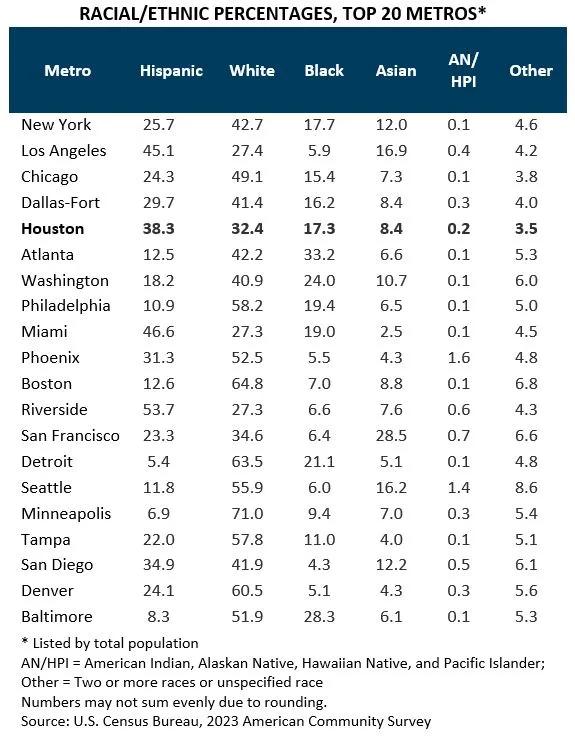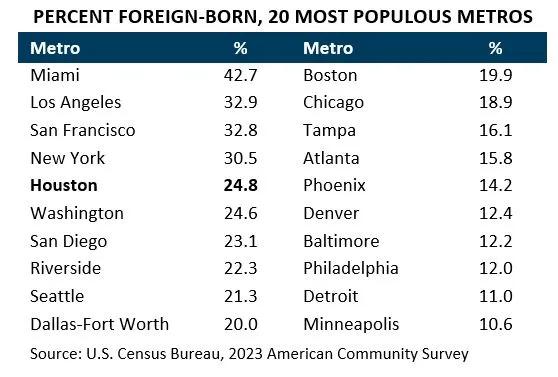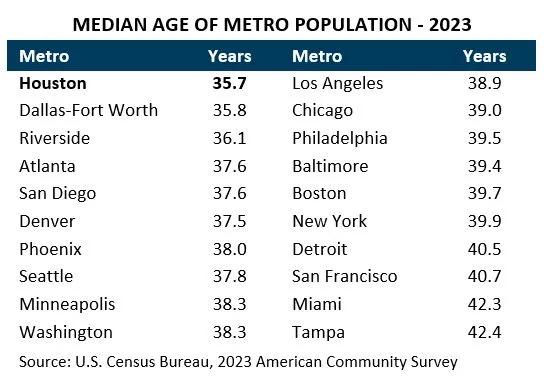


November Takeaway #1
Houston is the nation’s most racially and ethnically diverse major metro.
November Takeaway #2
Metro Houston has the youngest population among its peers.
November Takeaway #3
One in four Houstonians is foreign-born. Only four other metros have larger foreign-born populations.
A LOOK IN THE MIRROR
In the October issue of Houston: The Economy at a Glance, the Partnership analyzed data from the U.S. Census Bureau’s American Community Survey (ACS) to show how the region’s economic and demographic profile has shifted over the past 10 years.
Race and Ethnicity
In a nutshell, Houston is older, better educated, and more ethnically diverse. One in four Houstonians was born outside the U.S., the fastest growing age group is the 65 and older population, and one in seven Houstonians moved to a different home in ’23. However, fewer Houstonians are having babies, a large portion of the population remains uninsured, one in 10 suffers from a disability, and many households still live in poverty.
In this issue, the Partnership examines ACS data for the nation’s 20 most populous metro areas, exploring similarities and differences between Houston and its peers. Metro Houston includes Austin, Brazoria, Chambers, Fort Bend, Galveston, Harris, Liberty, Montgomery, San Jacinto, and Waller Counties.
Metro Houston has one of the youngest and most diverse populations in the U.S. The region also has one of the nation’s largest foreign-born populations. We’re in the middle of the pack for home ownership, but we lag in educational attainment and health care coverage. Houston also has the highest share of residents whose income falls below the poverty line and in the middle of the pack for home ownership. The details follow.
Race and Ethnicity
Houston is the nation’s most racially and ethnically diverse major metro. No individual race or ethnic group represents a majority of the region’s population. It’s been that way for over 20 years. Other metros also have large racial/ethnic populations, but they lack balance among the groups. For example, Los Angeles has a large Hispanic community but much smaller Black or White populations. Atlanta has a large Black community but few Hispanics or Asians. San Francisco has a large Asian community but few Black residents. Philadelphia has a large White community but fewer Asians.

Foreign-Born Population
One in four Houstonians (24.8 percent) is foreign-born—far more than the one in seven (14.3 percent) nationally. Among the nation’s 20 most populous metros, only four others—Miami, Los Angeles, San Francisco, and New York —have larger foreign-born populations.

Age
Metro Houston has the youngest population among its peers. The median age in Houston is 35.7 years, which means half of all residents are younger and half are older. The median age for the nation is 39.2.
Houston’s young population translates into a large supply of entry-level and early-career workers to meet local hiring needs, a substantial base of consumers entering their household formation and wealth-acquisition years, and a large population open to social change.

To continue reading, download this report.
Note: The geographic area referred to in this publication as “Houston,” "Houston Area” and “Metro Houston” is the ten-county Census designated metropolitan statistical area of Houston-Pasadena-The Woodlands-Sugar Land, TX. The ten counties are: Austin, Brazoria, Chambers, Fort Bend, Galveston, Harris, Liberty, Montgomery, San Jacinto, and Waller.

Key January Takeaways
Patrick Jankowski, CERP
Senior Vice President, Research
713-844-3616
Get more in-depth analysis from the Partnership team with a Membership.
